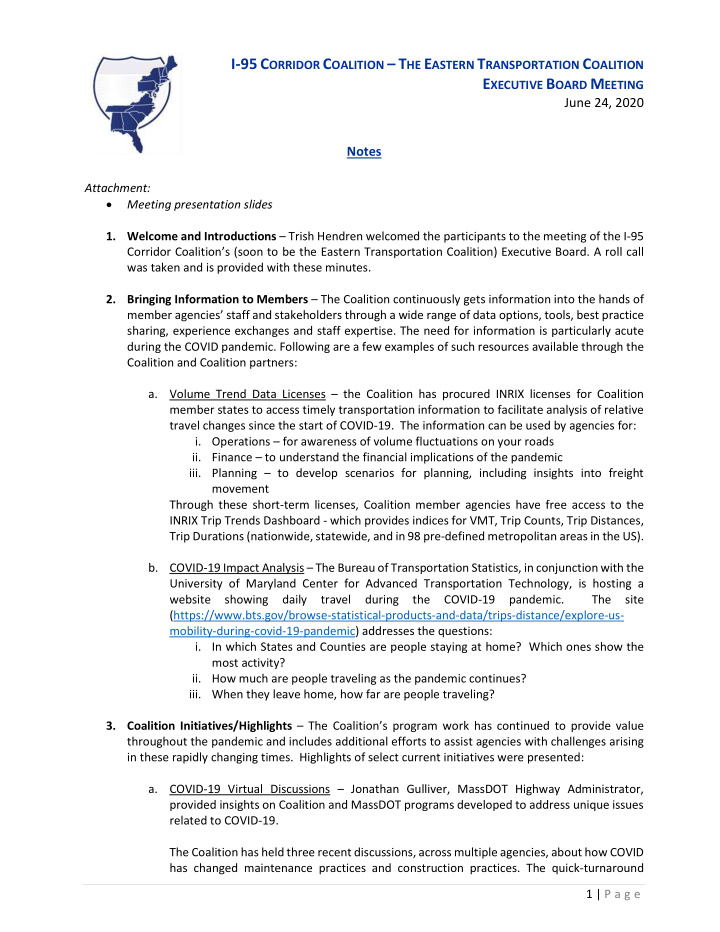



I-95 C ORRIDOR C OALITION – T HE E ASTERN T RANSPORTATION C OALITION E XECUTIVE B OARD M EETING June 24, 2020 Notes Attachment: • Meeting presentation slides 1. Welcome and Introductions – Trish Hendren welcomed the participants to the meeting of the I-95 Corridor Coalition’s (soon to be the Eastern Transportation Coalition) Executive Board. A roll call was taken and is provided with these minutes. 2. Bringing Information to Members – The Coalition continuously gets information into the hands of member agencies’ staff and stakeholders through a wide range of data options, tools, best practice sharing, experience exchanges and staff expertise. The need for information is particularly acute during the COVID pandemic. Following are a few examples of such resources available through the Coalition and Coalition partners: a. Volume Trend Data Licenses – the Coalition has procured INRIX licenses for Coalition member states to access timely transportation information to facilitate analysis of relative travel changes since the start of COVID-19. The information can be used by agencies for: i. Operations – for awareness of volume fluctuations on your roads ii. Finance – to understand the financial implications of the pandemic iii. Planning – to develop scenarios for planning, including insights into freight movement Through these short-term licenses, Coalition member agencies have free access to the INRIX Trip Trends Dashboard - which provides indices for VMT, Trip Counts, Trip Distances, Trip Durations (nationwide, statewide, and in 98 pre-defined metropolitan areas in the US). b. COVID-19 Impact Analysis – The Bureau of Transportation Statistics, in conjunction with the University of Maryland Center for Advanced Transportation Technology, is hosting a website showing daily travel during the COVID-19 pandemic. The site (https://www.bts.gov/browse-statistical-products-and-data/trips-distance/explore-us- mobility-during-covid-19-pandemic) addresses the questions: i. In which States and Counties are people staying at home? Which ones show the most activity? ii. How much are people traveling as the pandemic continues? iii. When they leave home, how far are people traveling? 3. Coalition Initiatives/Highlights – The Coalition’s program work has continued to provide value throughout the pandemic and includes additional efforts to assist agencies with challenges arising in these rapidly changing times. Highlights of select current initiatives were presented: a. COVID-19 Virtual Discussions – Jonathan Gulliver, MassDOT Highway Administrator, provided insights on Coalition and MassDOT programs developed to address unique issues related to COVID-19. The Coalition has held three recent discussions, across multiple agencies, about how COVID has changed maintenance practices and construction practices. The quick-turnaround 1 | P a g e
information exchanges were developed in response to member requests, and were held on May 13 (maintenance), June 9 (construction), and June 23 (maintenance). These exchanges brought together Chief Engineers, Directors, Administrators and other senior management across 14 member states to discuss (1) adjustments in procedures and personnel, (2) keeping employees safe, (3) innovative supply chain avenues, (4) adjustments to maintenance and construction practices, and (4) what is coming next. The Coalition was able to support member requests for timely information by organizing and delivering these round-robin discussions quickly. At MassDOT, focus during the pandemic has been on maintaining critical operations in the field and offices. For Field Operations: Maintenance and Construction staff continue to report to various locations. Through the peak, a staffing rotation was put in place for Maintenance staff on a weekly basis. MassDOT is currently at full staff with proper protocols. The Highway Operations Center continues to operate in two independent locations with dedicated staff. And for Office Staff, shifted to work from home, adjustments were made for connections with cloud technology, applications of e-signatures, and addressing bid openings and project development. COVID-19 Guidelines and Procedures issued by the Governor’s Office are followed by all construction sites and workers at all public work. Mr. Gulliver further described MassDOT’s “Shared Streets and Spaces Grant Program” and MassDOT’s Mobility Dashboard; details can be found at https://www.mass.gov/shared-streets-and-spaces- grant-program and at https://mobility-massdot.hub.arcgis.com/ respectively. b. Traveler Information Services Web Summit: Emerging Technologies to Improve Safety for Passenger & Commercial Vehicles – Greg Slater, Maryland DOT Secretary, noted that the Coalition held, on June 17, a virtual summit to learn how Coalition member agencies were using emerging technologies to improve safety for passenger and commercial vehicles. The summit hosted over 100 participants, representing 16 member states and multiple disciplines (DOTs, MPOs, Toll Authorities, Federal Agencies, Universities, Vendors, and Consultants). During the summit, five new traveler information services areas were highlighted: i. NJDOT: Use of Voice Assistance in 511 – this system, built off the current real-time data available on 511, enables drivers to get travel time and incident information more safely (through voice commands, rather than a phone keypad). ii. Using Technology to Alert Drivers – two new ways to communicate with drivers: 1. The Help Alerting System (being implemented in MD, PA, NJ and GA) allows the DOT to have a two-way communication via the Wireless Emergency Alert (WEA) system with people who are stopped on a road or approaching a hazardous area. 2. Using iHeart Radio for Highway Advisories, a Florida Turnpike pilot project, modernizes two existing technologies to provide another source of accurate and current traveler information to drivers. iii. PennDOT: TSMO Performance Program – PennDOT is expanding its data sources to increase awareness of travel conditions. For example, by augmenting their Road Condition Reporting System (RCRS) with INRIX and WAZE data they are able to detect a much higher percentage of crashes on the core network. Additionally, PennDOT is aware of crashes much earlier enabling them to (1) get information out faster to the public, and (2) respond to the incident faster. 2 | P a g e
Recommend
More recommend